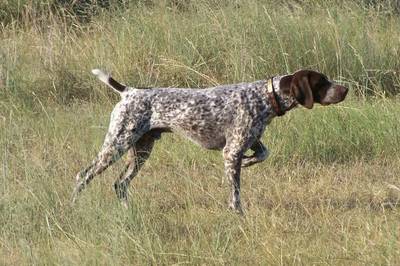| |
|
|
Pointer Information

Pointer Facts
| Size |
Medium |
| Male Max Weight |
55-70 lb |
| Female Max Weight |
45-60 lb |
| Life Span |
12-14 years |
| Energy Level |
 |
| Ease of Training |
 |
| Grooming |
 |
| Shedding |

|
| Exercise Requirements |

|
| Playfulness |

|
| Affection Level |

|
| Good With Dogs |

|
| Good With Pets |

|
| Good With Strangers |

|
| Watchdog Ability |

|
| Protection Ability |

|
| Cold Tolerance |

|
| Heat Tolerance |

|
Pointer Temperament
|
Pointers are excellent hunting dogs. The main reason for this is
their almost endless supply of energy. If you are big into bird hunting, the Pointer
would be your top choice to take with you. They can run around in circles and seemingly
never get tired or worn out. If your Pointer isn’t able to release its energy by doing
something constructive, then it actually could end up becoming frustrated and disruptive.
This dog’s DNA was essentially designed to hunt birds and if that is not what it is
doing, then it is looking for a way to do it. With that said, if you try to get your dog
to play games, it may be easily distracted by something as simple as a bird flying by. Do
understand that if a Pointer is on the hunt for a bird, it is very difficult to break its
focus.
|
Pointer Upkeep
|
A Pointer needs tons of exercise so if you live a sedentary
life, this may not be the dog for you. It is important that this breed receive at least
an hour of intense physical exertion every day to ensure that it is keeping its lean,
muscular body as healthy as possible. This is certainly not a breed that should be
subjected to the indoors all day. They are great for people who work-from-home or who
have huge fenced in backyards with a doggy door entrance so the dog and come and go as it
pleases. Pointers do best when they have another dog to play with; companionship is
almost vital to their development. Pointers also need to be interactive with their owners
to keep them feeling
involved.
|
Pointer Health Concerns
|
Chronic Hip Dysplasia (CHD) is a concern of this breed and you
should definitely take your Pointer to the vet if you notice any of the following
symptoms: limping, short-sided steps in their rear legs, problems climbing or descending
staircases, or tends to lag after heavy exercise. Hypothyroidism is another concern that
effects many Pointers if not taken care of properly so ensure that your Pointer is
exercised regularly. As they age, they also become susceptible to cataracts and deafness
more so than other breeds. It is important to get your Pointer checked out if they show
any signs of eyesight problems or if you begin to think they are not listening like they
used to; it is very possible that they are either forming cataracts or have hearing
issues.
|
Pointer History
|
In the 17th century, Pointers were initially recorded as the
breed that was used to chase rabbits. When wing-shooting popularity began to rise, people
discovered that Pointers were actually a phenomenal breed for hunting birds. If a Pointer
saw a bird, it would initially pause in its tracks, point to the location of the bird,
which is where the name “Pointer” came from, and then wait for the fellow hunter to aim
and shoot the bird. After the Spanish Succession, the British Army officers returned to
their homes with this new breed. At the time they were heavy-boned, but were later
crossed with Italian Pointers. This gave the Pointer the more modern look that they
display today. Although they fall in the category of amazing hunting dogs with
Greyhounds, Foxhounds, and Bloodhounds, they are not as popular for hunting as the other
three aforementioned
breeds.
|
Pointer Pictures
|
Puppies

Middle
Aged

Older

|
Pointer Videos
|
|
|








